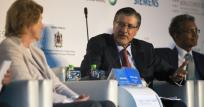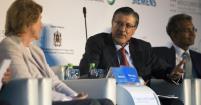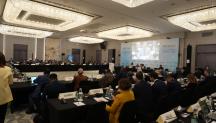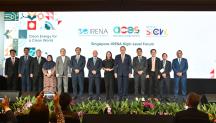

Decarbonising the Global Economy: Thinking Differently to Achieve a Renewable Energy Future
Newsletter
Building a renewable energy future will require new ways of thinking about the transformation of energy systems locally, regionally and globally. During a plenary session at the World Climate Summit on 13 November, held on the sidelines of COP22 in Marrakech, Morocco, a diverse panel of speakers discussed the kinds of innovations needed to achieve rapid deployment of renewables – starting now and accelerating deployment through to 2050.
IRENA Director General Adnan Z. Amin introduced the session with the observation that the transformation of the power sector is no longer an issue given that the business case has become so clear and compelling. The greater challenge, he said, lies with finding solutions for transport, heating and cooling, and energy intensive industries.
Dolf Gielen, the director of IRENA’s Innovation and Technology Centre, set the scene with a presentation of 2050 decarbonisation pathways, a forthcoming product coming out of the Agency’s REmap workstream. He noted that the national plans registered under the Paris Agreement would not be enough to achieve this, and that we need to multiply existing commitments three-fold. While the transformation is well underway in the power sector, increased focus needs to turn to other end use sectors including transport, heating and cooling and industry. Fortunately, he said, this transition is both technically feasible and economically beneficial.
Mustapha Bakkoury, CEO of the Moroccan Agency for Sustainable Energy (Masen) discussed the extraordinary progress his country has made towards the goal of securing 52% of its energy mix from renewable sources by 2030.
Paddy Padmanathan, President and CEO of the Saudi Arabia-based company ACWA Power International, described how his company set world records for low-cost wind and solar generation. But he also said that low costs are not achieved in a vacuum. He said that key factors for success include clear procurement policies, a strong enabling environment with clearly established rules, and a long-term mind-set amongst investors. With regard to decarbonizing other energy intensive sectors, he noted that ultimately it all comes down to electrification, and that it is therefore paramount to maintain focus on decarbonizing the electricity sector.
Marie Donnelly of the European Union focused her comments on heating and cooling, which she described as the “Cinderella of the energy sector, in that it never receives an invitation to the ball – despite being responsible for 50% of final energy use in Europe.” Given the large share of older (energy inefficient) buildings in Europe, the transformation has been challenging, but she emphasized that it is underway. She underscored the urgency, observing that we are only “1.5 investment cycles away from the 2050 end point.”
Daniel Kammen, of the University of California at Berkeley, discussed progress close at home and further afield. He talked about California’s efforts to achieve goals for a million solar rooftop installations, and a million electric vehicles, both by 2020. He lauded landmark legislation in California which requires land use policy to be consistent with the state’s sustainable transport goals.
He also highlighted progress in Kenya, as the first country in the world in the process of transitioning from one renewable energy source to another – from hydropower to geothermal. He identified “pay-as-you-go” systems in many grids as innovations benefiting African countries.
Two other speakers talked about Africa as well. Youba Sokona, headof the Africa Renewable Energy Initiative interim delivery units,] pointed out that for Africa it’s not about decarbonisation, but about jumpstarting acquisition in the first place. He applauded the work of the Africa Renewable Energy Initiative which was launched in Paris last year.
Bruno Bensasson of ENGIE South Africa explained that Africa needs reliable, competitive sources of energy, and that until recently renewable energy wasn’t seen as meeting either of those needs. This view is rapidly changing as costs have gone down. In order to scale up mini grids, he said, storage improvements were needed. He noted, however, that the problem wasn’t so much about technology as about the up-front capital investments for individuals.
"Bringing renewables to meet well over 50% of energy demand requires an energy transformation well beyond what we have seen thus far," said Mr. Amin in his closing remarks, adding, "but for the first time we are seeing a political pathway for decarbonisation take shape."




